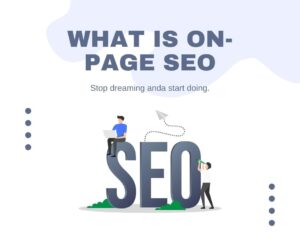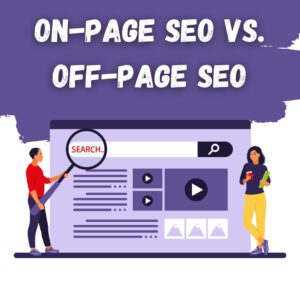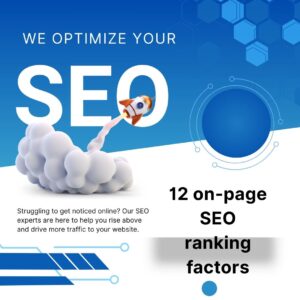Should you have a website for your business, you probably have an idea and the basics of SEO. But do you know about on-page SEO and its different optimizations that come into play for improving one’s visibility through search engines, and AI answer engines?
This page will contain all the information you need for on-page SEO, from its definition to the factors you need to optimize.
What is on-page SEO?

In the course of what is seo in digital marketing, relevant improvements are made to certain features of a web page that will assist in attaining top search positions within search engines.
An optimization that is performed on-site focuses on a web page’s contents and source code. These involve:
Writing and optimizing content for intent
Incorporating key phrases into the content
Improving the page speed
And more
You should look into improving your URLs, internal linking, page speed, title tags, and so on.
On-page SEO vs. off-page SEO: What’s the difference?

On-page SEO is different from off-page SEO, which is yet another word you will encounter when trying to enhance your online ranking. On-page SEO is optimization done to your website, and it refers to anything you do outside the website.
Creating and optimizing content according to understanding a search intent or fine-tuning your site structure for its navigation might serve as on-page examples of optimization. Off-page would be acquiring links from other known and reputable sites.
Indeed, one valid recipe for SEO success is a combination of on-page SEO and off-page SEO.
12 on-page SEO ranking factors to pay attention to now

Countless factors come into play when it comes to how seo works in digital marketing, but some are known only to the practitioners. In other words, some of these tried-and-true factors can be optimized today to improve ranking signals in the search engines.
On-page SEO influences have the following characteristics:
URL
Title tag
Meta description
Headings
Alt tags
Keywords
Content
Images
Page speed
Internal links
Schema markup
Mobile-friendly
Optimized for Featured Snippet
Let’s discuss these traits one by one:
1. Employ a descriptive and optimized URL
Upon probing the ideas presented by Google, it is just recommended that you use such URLs that directly tell site visitors what a page is about. Aside from that, parts of the URL might also appear in SERPs, revealing to searchers which pages could be useful for them.
This is thus part of the on-page how does seo works in digital marketing must-haves, which is a target keyword in your urls.
Upon probing the ideas presented by Google, it is just recommended that you use such URLs that directly tell site visitors what a page is about.
On-page SEO basic practices include putting that very keyword in your URLs.
Use clear, orderly URLs-leaving out those cluttered prefixes-to create even better architecture for your site, and find greater success in relevant search results.
2. Always put your target keywords in your title tag
Therefore, using keywords in each page’s title tag allows better understanding for search engine crawlers of what the website is about.
The title tag needs to be ideally kept around 50-60 characters, which is the length search engines prefer, without cutting off the keyword that should be kept at the beginning.
Every page should ideally have a unique title tag on the website so all different types of users can know what each page is really about.
3. Put in your meta-description text that will compel searchers to click on your page.
A meta description does not freshly mean any direct impact on your on-page optimization. It brings users closer to learning more about the page.
Whenever any search terms appear in your meta description, Google bolds them. The best results come from including your main and related keywords within your meta description.
Such is a meta description in our page about dog daycare services at Austin, which collates core business keywords among others.
For optimum performance, keep your meta description at around 160 characters.
4. Enhance content readability on your page with heading tags.
In your content, use heading tags to break up the content further, making it easier to read and skim through for its users.
For example, a dog daycare-related post can have the following headings:
What is included in dog daycare?
What is charge of dog daycare?
How to choose best dog daycare?
Make sure you emphasize the core keyword in your H1 heading as you compose your heading tags.
5. Use alt tags for your multimedia content.
You may also describe the image files themselves to help Google even more with understanding your multimedia.
Always include the alt tag with your multimedia. For users with disabilities, alt tags besides Google will help in ensuring accessibility for those who cannot visualize and interact with the content.
6. Be strategic in using your keywords.
All pages of your website must bear text contents that are more than themes-specific. But then again, optimize the page to match with the intent associated with the keyword searches.
Use keyword analysis tools such as KeywordsFX and Keywordtool.io in order to discern keywords people search with reference to your products and services.
Most of the time, small businesses have little-to-no other option, but to go for the longtail keywords or use of three to four-word phrases.
It is always easier to decode search intent against these long-tail keywords due to their specificity.
7. Publish helpful content for your audience
Certainly, foreseeing the background contents in onsite optimization, in fact, would be considered in 72% of the worthiness of marketing to be content creation.
While content is the only thing that can bring a user to your site, it is the blog or product page that they will really be traversing having a look. The process of optimizing your content usually helps search engines find, understand, and rank it so that it will be found by people.
The placement of useful content in asseverating rankings in search engines matters a lot. The content which Google typically prefers covers the E-E-A-T standard of experience, skill, authority, and trust. Such E-E-A-T could be established with hire of citing plausible sources, embedding signals of trust, and thereby getting an author bio for credibility.
Outside of E-E-A-T, helpful content can be written by:
Embedding your keywords in headings and paragraphs
Using skimmable headings
Providing relevant images
Writing with proper spelling and grammar
Do not forget to be updating your site regularly with new pages of content for search engines to see that you are really working hard for your customers. Consider revisiting and refreshing your website content to ensure it contains newly updated information.
8. Use high-quality and compressed images
The best quality images will be user-SEO-formulated. Images will very well help the visitors understand the contents present on your site.
Content can be broken down with images. These also provide definition to certain complicated processes or those difficult to describe features.
Here are some image SEO best practices:
Compress images so that it does not slow the page speed since it can affect page loading speed.
Add alt text for accessibility and ranking on Google Images.
Usability features include something like transcriptions for videos.
Another nice place to drop your target keywords is in transcriptions and alt text; joining them will also make your site ADA compliant.
9. Mind your site speed
Would you actually have the patience to wait for a web page for two minutes?
Like you, most users on the internet will pogo-stick off any page that takes time to load. Fun fin facts: 83% of web users expect a website to load within 3 seconds.
Therefore, it is important to have a very fast speed in order to provide a good on-page experience in this regard as search engines, such as Google, rank websites according to page speeds.
Page Load Speed Test: PageSpeed Insights generates customized recommendations for speeding up a site.
10. Add internal links
Internal linking is often ignored in the realm of what is the role of seo in digital marketing. However, as a website matures, it becomes important to have an internal-linking strategy. This is because internal linking helps crawlers explore your website, discover new content, and understand the context of diverse pages.
In a workflow where an internal link is seldom provided, users are deprived of content valuable to them on your site. When they are unable to access such information, this will greatly hinder your chances of making a conversion.
Using internal links to further its own on-page SEO;
Add links in new posts to relevant, existing content
Add links from relevant, existing content to newly created pages As far as internal linking strategies go, every single one is quite different; however, two to three links should be given to every new page going out to create the maximum effect. If you have forms of page entries in mind but feel impossible to find very suitable pages, do not force a link; it probably will benefit much more to have you build pillar content.
You can check Screaming Frog for internal linking status for free.
11. Add schema markup
If you want your page to rank well on the SERPs, you’d better use schema markups. Schema markup, also referred to as structured data, is the code that actually assists search engines to better understand and classify web pages.
It may also boast rich results: a class of search results that display outside information about a page, making it more engaging and attracting more clicks. This could probably improve your click-through rates in the SERPs.
There are types of schema markup. One of the most common is product markup: it provides all the information related to an offering’s price and review ratings.
Schema markup might also allow your content to show up in Google’s AI Overviews and within other answer engines. Schema marking, in actuality, gives AI models more insight regarding your page.
12. Make your website mobile-friendly
It is very important to optimize a site for mobile because more than 50% of traffic on the internet comes through mobile devices. In fact, Google Indexes websites with a mobile first approach.
Mobile compatibility is not an option anymore. It is necessary, especially if you’re interested in ranking for your keywords.
Responsive means you´ve got just one site, making updates and new content easy to manage.
Test your site on mobile using tools like Google Lighthouse.
13. Optimize for featured snippets
Another on-page factor for SEO optimization is featured snippet, or position 0 optimization. A featured snippet is a box that appears on top of certain search Marketingblog and provides useful information for searchers.
This box is usually the first element an eye catches among all other listings on the page.
You can optimize your on-page content for this feature by:
Directly and concisely answering questions,
Using bulleted lists to summarize information,
Creating sections that Google can directly pull Q&A answers from,
Using features like tables and lists to summarize information.
